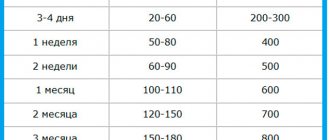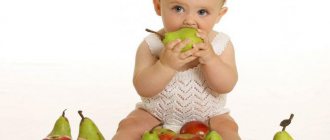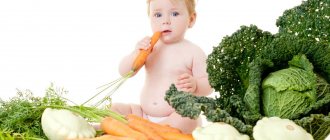Gradually, you can introduce the following products into the menu of a 10-month-old child.
- Fish The fish you feed your baby should be lean and not red. Since such food can cause allergies, you need to be careful. Give your baby no more than 30 g of fish, no more than once every 5 days, and be sure to monitor his body’s reaction. You can simply boil the fish and turn it into puree, or you can make steamed meatballs or soufflés. Before serving, carefully check that there are no seeds in it.
- Cottage cheese, kefir, yogurt You've probably heard that fermented milk products are needed for the development and health of bones. A child's diet at 10 months can include up to 50 g of cottage cheese and 100 ml of kefir or yogurt daily. Often children refuse to eat just cottage cheese. Try adding it to a casserole or making pudding.
- Fruit juices and purees The best choice for children living in our latitudes would be natural juices and purees from apples and pears. It's ideal if you cook them yourself. If you have a juicer, making a tasty and healthy drink will be very easy. It is not advisable to add sugar to juice. And the procedure for introducing new fruits into the baby’s diet is the same as for vegetables.
- Egg yolk The baby already became acquainted with it last month, and it’s time to increase the dosage: up to 1-2 quail yolks or half a chicken yolk per day. Be sure to hard-boil the eggs until fully cooked.
What should not be included in a 10 month old baby's menu?
Pediatricians strongly recommend refraining from including the following products in the menu of a 10-month-old child, in any quantities:
- goat and cow whole milk;
- citrus fruits (in general, it is advisable not to give your baby any exotic fruits yet, except for international anti-allergens - bananas);
- honey, condensed milk, chocolate and candies;
- any semi-finished products;
- saltiness, smoked, canned foods (except for baby food).
Read in detail about allergies in a child under one year old.
Basic products that should be present in the diet
What should be in the diet of a ten-month-old child? It is recommended to include the following products in the daily menu:
Vegetable puree. The daily value for children aged 10 months is approximately 130 grams. It is recommended to prepare vegetable puree from potatoes, zucchini, pumpkin, carrots, Brussels sprouts and white cabbage.
Meat. Without this product, breastfeeding and artificial feeding of a child is unthinkable. It is recommended to give meat to the baby daily. Preference should be given to rabbit, turkey, chicken, and veal. In addition, the baby’s diet should also contain offal. They are used as a base for cutlets, soufflés or pates.
Fish. Dietary regimens for a child at 10 months involve preparing a variety of fish dishes. This product contains a large amount of polyunsaturated acids.
You can make meatballs or steamed cutlets from fish. For cooking, it is recommended to use such types of fish as pollock, hake, and cod.
Vegetable oil. This product is added to porridge or vegetable purees. The optimal norm for a ten-month-old baby is two teaspoons of vegetable oil per day.
Gluten-free porridges. A healthy dish saturates the baby’s body with essential nutrients. To prepare porridges, types of cereals such as rice, oats or buckwheat are used.
Butter (no more than two teaspoons per day). If the child is prone to allergic reactions, the product must first be melted.
Sample menu for a 10 month old baby
A baby's first morning meal at 10 months should consist of mother's milk or age-appropriate infant formula.
In a couple of hours - the second, aka “adult” breakfast. An excellent option would be porridge cooked with milk, fruit, cottage cheese or a curd dish.
It is recommended that a child’s lunch, like an adult’s, consist of the first and second courses: soup and a meat dish.
Organize your baby's dinner quite light - vegetable puree interspersed with egg yolk, fruit juice. Shortly before bedtime, give your child kefir, yogurt or fermented baked milk.
Be sure to give your baby something to drink between meals. Water, homemade unsweetened freshly brewed compotes, and special children's teas are perfect for this.
Approximate feeding schedule for a 10 month old baby
Since a child’s menu at 10 months can already be considered maximum, it is almost no longer important whether he drinks breast milk or an artificial formula. The only thing that matters is whether the child has a food allergy - at this age, an allergy to cow protein is especially relevant. Naturally, the feeding scheme for a 10-month-old child takes into account the child’s tastes, which by this time are already beginning to emerge.
An approximate feeding schedule for a 10 month old baby is as follows.
6 a.m
Early morning feeding is still the most convenient and familiar. Mothers give their babies breast milk or a formula that replaces it as usual. Please note that when feeding children with protein allergies, a safe fermented milk product or soy formula is used. Serving size 200-220 ml.
10 a.m
Completely healthy children receive 120-130 grams of milk porridge with butter and 90 grams of fruit puree for lunch. Allergy sufferers should be fed milk-free porridge (with the exception of breast milk or fermented milk product) - serving size is 170 grams. Use vegetable or ghee as a dressing. Fruit puree is a must in an allergy sufferer’s diet, but when choosing fruit you should give preference to hypoallergenic products: green apples, pears, plums.
2 p.m.
At lunch, kids enjoy eating vegetables (serving size 140-150 grams) seasoned with vegetable oil. Every other day, give your baby half the yolk of a hard-boiled egg, alternate meat puree (60 grams) with fish puree (40 grams). Teach your child that bread is also food, and offer compote or fruit juice as a drink.
6 p.m.
The fourth feeding for completely healthy babies includes breast milk or formula (100-120 grams), a 50-gram serving of cottage cheese, 50 ml of fruit and/or vegetable juice and cookies. Children with allergies eat more adult foods: cereal and vegetable puree with vegetable oil (160 grams), a portion of lean meat (30 grams) and fruit puree (30 grams).
10 p.m.
Before falling asleep at night, the baby should eat his usual food - breast milk or formula to which he is accustomed. The serving size is standard – 200-220 grams. You can also offer your baby a favorite dish based on the main product.
However, the feeding plan for a 10-month-old child presented above is, of course, very approximate. You can easily diversify it by adding a personal “zest” to your baby’s nutrition.
Also, do not forget that for a healthy child at 10 months it is important to receive up to 100-150 ml of additional fluid in normal conditions and up to 180-200 ml in hot weather. Give preference to boiled water, apple infusion and rosehip decoction - these drinks are the safest and healthiest for the baby.
Recipes for a 10 month old baby
Turkey with carrots and apples
You will need:
carrots – 1 – 2 pcs;
turkey fillet – 50 g;
milk – 3 tbsp. l.;
apple – 0.5 pcs.
And we will cook like this:
Finely chop the carrots and place them in a saucepan or steamer. You need to cook the vegetable for about 10 minutes. Meanwhile, peel the apple, grate it on a fine grater, add a spoonful of milk and simmer for 5 minutes.
Blend the boiled carrots and remaining milk in a blender to a smooth puree and mix with the apple mixture.
Boil the turkey in a double boiler or bake it in foil and chop it so that small pieces remain - it’s time for the baby to learn to chew. Serve the meat with vegetable puree.
Features of preparing first courses
What should be given to a 10 month old baby as a first course? You can pamper your baby with these soups:
- children's borscht;
- millet soup with vegetables;
- the first course, the main ingredients of which are rice and turkey.
Important! The broth should not be too rich. Therefore, it is recommended to drain the first water from the pan soon after the meat boils. It is allowed to add a small amount of salt to soups: no more than three grams.
How to properly feed a 10 month old baby?
During the period of drinking exclusively mother's milk or an adapted formula, most children receive food on demand. Meals at 10 months should be organized according to a schedule. The baby’s body gradually gets used to rationally spending energy and storing it. It is important to follow the recommended portions of food so as not to create excessive stress on the baby’s gastrointestinal tract.
Diet at 10 months
The breaks between feedings of an almost one-year-old baby are 3-4 hours. According to the advice of pediatricians, the optimal amount of times to feed a child at 10 months is 5 meals. The first is carried out immediately after waking up, at 7-8 am. The last meal is around 22-23 hours. A child's diet at 10 months may additionally include light snacks:
- diced apple;
- cookie;
- cracker;
- crust of bread;
- yogurt;
- kefir;
- carrots and other products.
What to feed a 10 month old baby - menu
It’s easy to organize your baby’s diet if you make a list of dishes for each day in advance. Parents must figure out on their own what to feed their 10-month-old baby - food preparation recipes are as simple as possible. You need to pay attention to what the baby likes best and what dishes he is indifferent to (or refuses). Additionally, you need to monitor the body’s reactions. If an allergy occurs to a new product, it is excluded from the diet.
Nutrition at 10 months, menu for 1 day (approximate):
- Breakfast
- mother's milk or artificial formula, 200 ml. - Second breakfast
- porridge with water or milk (200 g) with butter (5 g) and half an yolk. Fruit mousse and compote (50 ml each). - Lunch
– soup (200 ml) or vegetable puree in the same quantity, seasoned with vegetable oil (5 ml). A piece of bread, 10 g. Meat puree, 80 g. Twice a week it is replaced with fish, 50 g. Compote or fruit drink - 55-60 ml. - Afternoon snack
– cottage cheese, 50 g. Fruit puree, 60 g. Any fermented milk product (200 ml) with cookies or crackers. - Dinner
– breast milk or ready-made formula.
What can a 10 month old baby drink?
Many parents buy children's fruit juices for their children, but modern studies have shown that they contain too much glucose and few nutrients. It is better if a child’s diet at 10 months includes homemade drinks. You can squeeze the juice yourself and dilute it with water. Alternative options are fruit drinks, compotes and jelly. They contain a maximum of vitamins and minerals. Additionally, a child’s nutrition at 9-10 months may include the following drinks (in addition to milk and formula):
- still water;
- dried fruits compote;
- rosehip and fennel tea.
Breastfeeding at 10 months
On the eve of 1 year of age, breast milk constitutes a minimal part of a baby’s diet, no more than 400 ml per day. Feeding a ten-month-old baby involves infrequent breastfeeding, mainly before bedtime and after waking up. Pediatricians do not yet recommend weaning the baby completely. It is advisable that a ten-month-old baby's diet include breast milk every day. It produces many positive effects on the body:
- rapid recovery of strength;
- strengthening the emotional connection with mom;
- easy falling asleep;
- immune system support;
- mild correction of intestinal microflora and others.
What can you feed a 10 month old baby?
- Vegetable purees. Almost all representatives of this group of products are already acceptable. It is allowed to add greens and onions, especially when preparing soups.
- Green peas (fresh), spinach.
- Fruits and berries (mashed potatoes, compotes, juices, jelly). The baby can do everything, with the exception of red fruits, exotic fruits and citrus fruits.
- Porridge. Gluten-free still has the advantage. However, you can already start introducing oatmeal.
“We introduce oatmeal into baby’s complementary foods”
- Meat. In addition to low-fat varieties, you can slowly introduce veal and young pork. Prepare meatballs, steam cutlets, add meat to soup.
- Fish. It is still better to feed representatives of varieties with low fat content. Gradual introduction of species with medium fat content is also allowed.
- Dairy products. You can give your baby kefir, but not too fatty and sour, yogurt and cottage cheese.
When my sister gave kefir to her child for the first time, the baby grimaced violently and spat everything out. The sister decided that this product was not suitable for them and decided to exclude it from the diet. And somehow I asked her if the baby drinks this drink. When I found out the reason for the cancellation, I was very surprised. I explained to my sister that, most likely, it was simply too sour and that is why the child did not like it. Together we decided to try again. I made homemade kefir, tasted it, and made sure it had acceptable acidity. Only after that we let the little one try this drink. As I expected, she liked it.
“We introduce kefir into baby’s complementary foods”
- Egg yolk. Protein is gradually introduced.
- Milk. The baby has already tried goat's milk, now you can start getting acquainted with cow's milk. Although some experts recommend waiting to introduce this product for up to a year. When complementary feeding just begins, it is worth diluting milk with water (1:3), then reducing this proportion (1:2, 1:1).
“We introduce cow’s milk into complementary foods”
- Wheat bread and cookies (biscuits).
- Pasta.
- Oil. It’s already possible, both creamy and vegetable. But in small quantities. Add to soup or porridge, vegetable puree.
- Salt and sugar in small quantities.
- Breast milk or formula. Still present in the toddler’s diet.
- Drinks: decoctions of herbs and rose hips, jelly, juices, compotes, herbal teas.
What not to do
A number of foods are still prohibited for the baby. These include:
- Whole milk (goat, cow). You can only give it diluted with water, and only when preparing porridges or milk soups.
- Citrus and exotic fruits. You should also be careful with red fruits.
- Grape. It can cause severe bloating in the baby.
- Raw eggs, both chicken and quail. And even homemade ones.
- Sweets, especially chocolate.
- Semolina.
- Fatty fish and very fatty meat.
- Nuts.
- Bread made from rye flour.
- Smoked meats, preserves and pickles.











